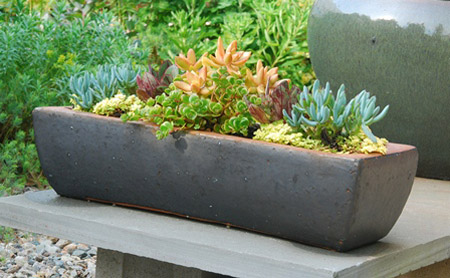
All photos in this post are credited to Avant Gardens.
As a gardener with particular tastes and interests that border on obsession, it’s always a treat to meet someone who shares the same enthusiasm and passions. I was introduced to Katherine Tracy and her nursery Avant Gardens (located in Dartmouth, Massachusetts) through Margaret, who found out about this off-the-beaten-track plant treasure trove by word-of-mouth through some of her gardening friends. “She’s one of us,” Margaret explained, meaning to say through verbal shorthand that she’s a bit plant crazy (the best kind of crazy) and with impeccable taste to boot (because, of course, being somewhat mad, we happen to believe our own tastes in plants are impeccable). Collectors of unusual and interesting plants since the 1980s, owners Katherine and Chris Tracey sell all manner of colourful foliage and dependable perennials. Like many of the most interesting nurseries, their business got started by way of a personal passion that simply got out of hand. They began doing mail order in 1997, focussing on uncommon annuals, but gradually moved on to include some of the perennials, trees, and shrubs they personally grew as well.
What stood out to me immediately was their succulent selection. Bring them all to me, I thought while compiling a mental wishlist as long as my arm. Just look at this variegated opuntia (Opuntia cochenillifera variegata). It’s an opuntia (one of my obsessions) and it is variegated (another problem area)! If it’s colour that you’re after, they have it in droves. Sedum japonicum ‘Tokyo Sun’ is blindingly yellow. Or how about Sedeveria ‘Jet Beads’? Sedum forsterianum ‘Antique Grill’ is a wonderful hodgepodge of reds and blues and it is cold hardy in my zone 5-6ish garden. She also conducts workshops on making succulent wreathes and has a handy how-to on her blog (called Garden Foreplay by-the-way!) — something I’ve been reluctant to delve into given my cold climate. I have to admit that her work in this area has emboldened me to let go of my own trepidation around tender succulents and I am already dreaming about how I can use them in gutsier ways this coming growing season. I had a chance to talk with Katherine about her work, and ask her a few questions about how she works with tender succulents despite living in a cold, New England climate. Q: Looking through your catalogue, I have observed a few common threads: succulents, containers, alpine troughs, and drought tolerant plants. Of course, this may be through the lens of my own bias. I also see plants with bold color and interesting shapes and form. Can you tell us a bit about your personal gardening interests and the sort of plants you collect and carry in the shop? Katherine: As you can tell from our plant list, I don’t like to limit myself, but there are only so many hours in the day… One thing 25 years + of gardening experience has taught me is to learn which plants have earned their spot in the garden. What qualifies: They need to be reliable (if a perennial, then it should come back next year, if properly sited), they need to look good for more than a few weeks of blooming (good foliage, long or recurrent bloom), and in many cases have low water requirements once established. Of course here in New England our weather and precipitation patterns are so variable. Last year was most unpredictable here: Mild winter, frost free March, 80 degree days and 25 degree nights in April, dry May, June, July, moist August and September…. Totally out of what you would predict for New England, Also, we have, as do some other folks, low lying wet areas on our property where plants which prefer dry conditions would perish, so we also have plant selections that are going to be happily perennial in wet soils too. Tips for Growing Succulents in Pots Q: You have a gift for creating stunning succulent plantings in containers. Any tips for beginners when it comes to mixing and matching in pots? A few hints: Start with an attractive pot. It can be quite shallow, but doesn’t need to be. Deep pots can be filled with something that will take up space and allow moisture to be wicked away. Consider which plants and their colors tones you will be using and see how they work with your container. Use a well drained, gritty soil mix. Select a variety of forms and textures, plus try to select plants that vary in tone… light coloring, medium and dark tones. Also, the old standby formula for container plant selection: select a thriller (showiest plant, something with height perhaps), a filler (fills the body of the composition with complementary color and textures), and a spiller ( a plant that will spill and trail over the sides of a pot). Don’t be stingy. Showy succulents like Echeveria and Aeonium don’t grow fast, so you shouldn’t leave a lot of room for growth in the pots, since you’ve only got 4-5 months for everything to fill in and look good. Succulents are not heavy feeders or thirsty, so you can pack a lot of plants in a container without harm (that’s why ours look so lush). If certain filler or spiller plants take off too fast, cut them back, stick the cuttings elsewhere. If you don’t have the resources or want to spend a lot of money, start with a small container but make it nice and full. Since succulents are so easy to winter indoors on a sunny window sill, your investment this year will be around to contribute in a bigger way next season. Grow a Succulent Wreath Q: You feature a succulent wreath how-to on your website and also teach workshops. I’ve been hesitant to try out succulent wreathes because inevitably I want to use decorative succulents such as echeverias that are not hardy in the north and it all seems like it would be a hassle to over winter in a cold climate. My impression is that it is a project best suited to warm and temperate climates where they can be kept outdoors year-round. And yet, you live in New England and you’re doing it. What’s your secret? Katherine: Remember this: growing plants (any plants) in a circular ring is quite an abnormal way for the plants. We’re manipulating them to suit our design preferences. Expect a season out of them, and then you’ll have to work at cutting back, regenerating, new growth, removing plant cuttings that die or no longer work. And really, a season of beauty is a long time. Think of how short a period a cut flower bouquet lasts. You may have to disassemble the wreath after a certain time, and what you can do is either replant the succulents if they have roots, or take cuttings and root them for more projects. One thing is true, succulent wreaths draw ooh’s and ah’s from everyone, and the beauty factor alone is worth the effort. It’s fun, and it’s easy. You do need a large number of succulent cuttings to do even a small wreath, so tell people if they are interested to start collecting! [Ed Note: Avant Gardens sells a handy succulent wreath kit that comes complete with a selection of 100 cuttings.] You can create a lovely wreath made of hardy succulents (although the hardiest forms lack the desert hues that are so lovely in the non hardy forms), and you could winter that over in a cold frame outside. A point to make is that just as plants succumb to winter cold in a pot outdoors, the same thing can happen to the hardy succulent wreath hung on your door. The Wide World of Succulent Plants Q: I’ve heard through the grapevine that you are working to ID improperly tagged succulents.I find this very intriguing as I can relate to having purchased many succulents over the years from oddball places (corner shops and such) that were very obviously misidentified. Can you tell us a little bit about this undertaking? Katherine: I sell plants, and I really want to sell them by their correct name. One thing to note is that there are a lot of intergeneric crosses between Sedum, Graptopetalum, and Echeveria. Often the inflorescense is the key…x Graptoveria, which looks like an Echeveria rosette, but it’s flowers suggest Graptopetalum. The Latin names also scare people, so I’m wary of going into this too much — it’s confusing for me as well. I would mention that if a gardener is suspicious of the name of the plant she/he is growing, he/she should observe her/his plants.. and note subtle differences in the way it grows (upright or spreading, freely puts out offsets, or is moncarpic, when it flowers (winter most likely), flower shape and color, and how the flowers are held on their stems. A few websites that have proven quite reliable are: DesertTropicals and The Succulent Plant Pages. No one book out there is the answer. They help, but photos need to be good, and there are new cultivars and crosses all the time. To learn more about Avant Gardens and growing succulents, check out Katherine’s blog, Garden Foreplay, or Margaret Roach’s podcast with her. Disclosure: Avant Gardens is currently a year-long sponsor of You Grow Girl.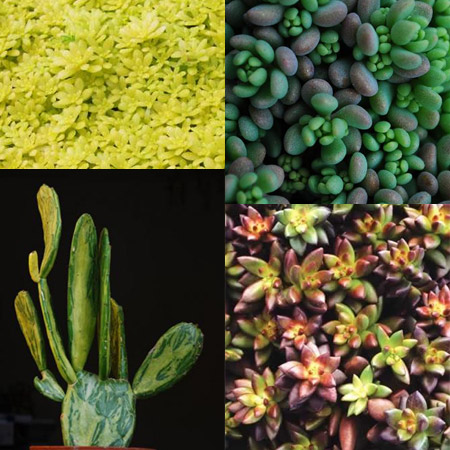
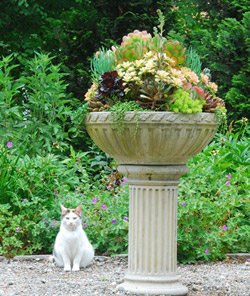 Digging deeper into the site, I am also intrigued by Katherine’s gift for designing colourful and captivating mixed succulent pots. While I tend to do mixes on a smaller scale or keep my plants in their own specimen pots for easy grouping, Katherine approaches succulent containers on a dramatic, grand scale and isn’t afraid to put together large and elaborate feature planters that mix both tender and cold hardy plants.
Digging deeper into the site, I am also intrigued by Katherine’s gift for designing colourful and captivating mixed succulent pots. While I tend to do mixes on a smaller scale or keep my plants in their own specimen pots for easy grouping, Katherine approaches succulent containers on a dramatic, grand scale and isn’t afraid to put together large and elaborate feature planters that mix both tender and cold hardy plants. 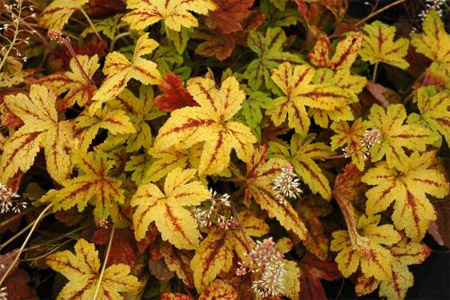
Heucherella ‘Sunrise Falls’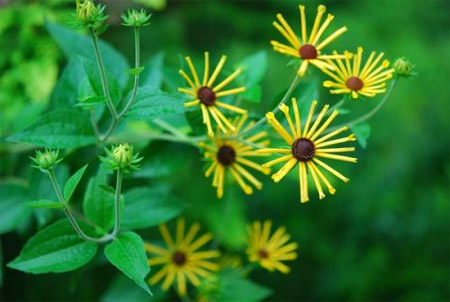
Rudbeckia subtomentos ‘Little Henry’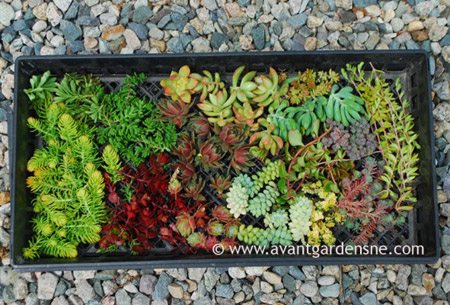
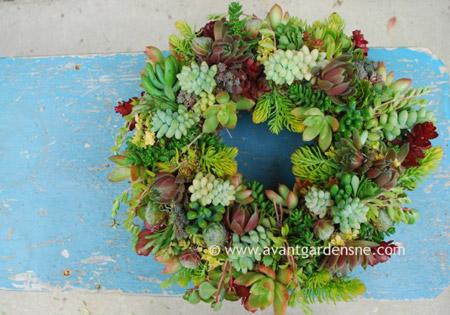
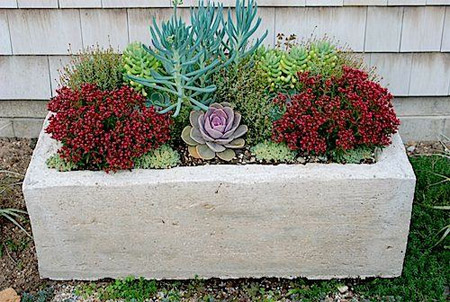
Plus, there’s a book or two in my future…and if I get enough good images of correctly named succulents in my portfolio, a book on succulents just might get published.
I love this posting! The picture with the converted bird bath and the cat posing is a great photo!! :-)!!!
Ah! Succulents! Yet another way to diversify our gardens. Thank you for a great post on my new “obsession”. After many years of buying perennials for my rose garden I re-discovered these wonderful plants this past year. Our New Orleans weather allows for an abundant show of these plants year round. The different look of succulents provides a great contrast to the rose bushes. I placed them in the same pots as some of my roses and they make a great ground cover there.
I really, really like succulents. That’s saying a lot considering I basically refuse to plant anything that isn’t edible. I finally planted some succulents cuttings that a friend let me plant and it took off, so perhaps I will have to get some more in the near future!
My cats never post for photos like that. I would love to have more succulents but I seem to kill them so easily.
Succulents are the best. Maybe not the most striking, but they never let you down.
I make arrangements like these for every little corner of the garden, because I do not like to water the ornamental plants, when I need the water for vegetables. In our climate, the less attention you give to succulents, the more they thrive.
I am a sucker for succulents, adoring their geometry, diversity and hardiness. I researched how to layer a berm, constructing about 15″ of layered rubble, gravel, sand, soil, etc and having it raised to insure drainage. I found it in a library book. I added driftwood and large rocks, edging the arc shape with ancient bricks found on Freecycle. I have been well rewarded for the time invested. The winter colors of the Sempervivums and the Sedums are like a candy counter and so appreciated when the rest of the yard is brown or gray in its dormancy. I never tire of strolling past.
At the moment, I have no less than 10 wreath rings for succulent wreaths patiently waiting in my garage. I made one 2 years ago in the wrong kind of frame, but it was beautiful nonetheless. The pieces were all recycled into strawberry jars or back into the berm afterward.The rate of spread is impressive and there will be many to share.
Thanks for this inspiring post.
Off topic, but I made your creme de menthe recipe. Two batches, one wih common garden mint and the other with peppermint, and both were delicious, especially the peppermint version shich i still have and am leaving the herb to steep in it for longer than the two days in the recipe. I tried to post on the thread from last year where you posted the recipe but it wouldn’t let me.
Yes, commenting expires after a few months… otherwise I’d be answering questions on the thousands of posts that are on the site for years to come!
I’m glad to hear it worked out. It’s fun trying it with different types of mint.
I love this website because even posts about a sponsor are beautiful and fascinating.
I’m glad to hear that. I am very careful about choosing sponsors and how I work with them. It’s important to me that there is always useful, real information for readers and not a bunch of garbage.
The wife and I keep trying to grow a garden and continually have mediocre success. However, the three succulents we planted two years ago keep coming back despite our efforts.
They are kind of our ego boosters, and I have a soft spot for them since they keep encouraging us to try.
I absolutely love the vivid images you present. I never knew that succulents could be so beautiful.
Very interesting article, I was wondering if you have ever tried to grow them yourself from seed? Thank you, Mary
I have indeed and I’ve had a lot of great success with it. There are a few articles on here about my experiments growing lithops and assorted cacti from seed, but I plan to write more this year as I already have a number underneath lights as I write this.